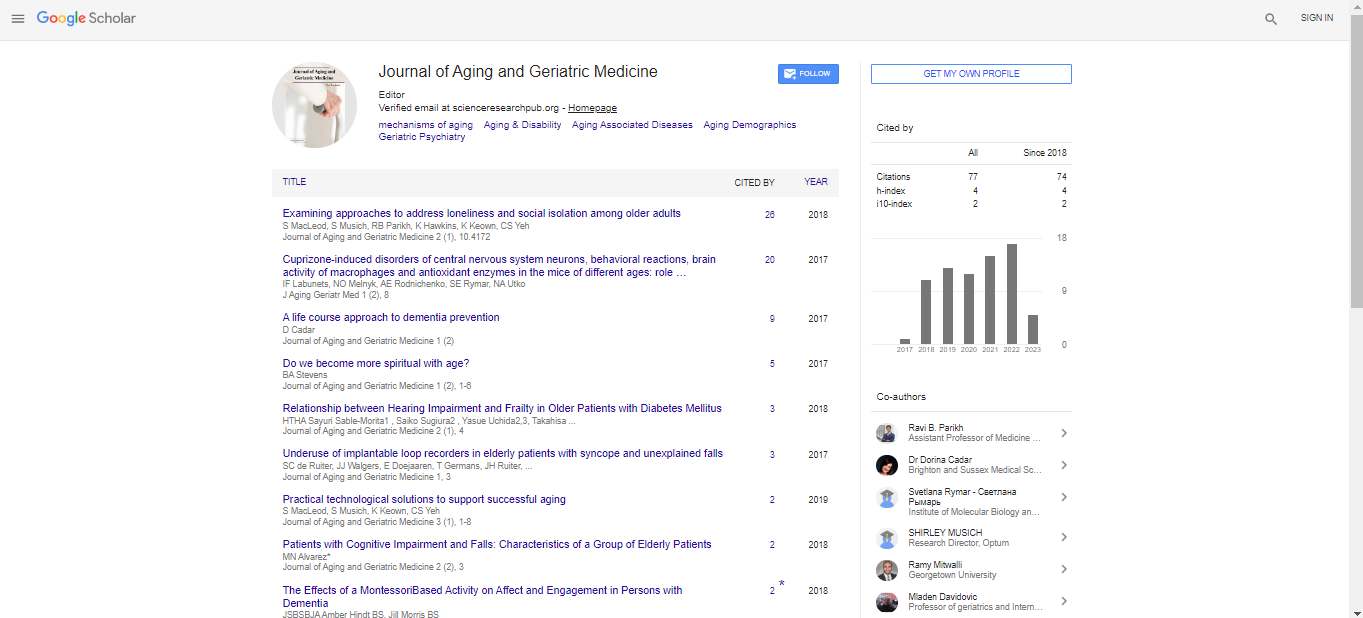Perspective, J Aging Geriatr Med Vol: 7 Issue: 1
Geriatric Pharmacotherapy: Considerations for Pharmacokinetic and Pharmacodynamic Variability
Li-Tsang Haung*
1Department of Emergency Medicine, Taipei General Hospital, Taipei, Taiwan
*Corresponding Author: Li-Tsang Haung
Department of Emergency Medicine,
Taipei General Hospital, Taipei, Taiwan
E-mail: tsangli@vghtpe.edu.tw
Received date: 02 January, 2023, Manuscript no. AGM-23-95450;
Editor assigned date: 04 January, 2023, PreQC No. AGM-23-95450(PQ);
Reviewed date: 25 January, 2023, QC No. AGM-23-95450;
Revised date: 02 February, 2023, Manuscript No. AGM-23-95450(R);
Published date: 08 February, 2023, DOI:10.4172/2576-3946.1000147
Citation: Haung L (2023) Geriatric Pharmacotherapy: Considerations for Pharmacokinetic and Pharmacodynamic Variability. J Aging Geriatr Med 7:1.
Description
Pharmacokinetics and pharmacodynamics are essential aspects of drug therapy that must be considered when treating geriatric patients. Pharmacokinetics refers to the study of how drugs are absorbed, distributed, metabolized, and excreted by the body, while pharmacodynamics refers to the study of how drugs interact with the body to produce their therapeutic effects. Both of these factors can be affected by aging, which can have significant implications for drug therapy in older adults.
Pharmacokinetic considerations in geriatric patients
Absorption: As patients age, there may be changes in their gastrointestinal tract, such as decreased gastric acidity, decreased gastrointestinal motility, and reduced intestinal blood flow. These changes can affect the absorption of drugs, leading to altered bioavailability and slower onset of action. Additionally, changes in the oral cavity, such as decreased saliva production, can affect the absorption of drugs administered orally.
Distribution: Changes in body composition, such as a decrease in lean body mass and an increase in adipose tissue, can affect drug distribution in geriatric patients. This can lead to a larger volume of distribution for lipophilic drugs, which can increase the half-life of drugs in the body. Additionally, changes in protein binding can affect the distribution of drugs, leading to an increased concentration of free drugs in the blood.
Metabolism: The liver plays a significant role in drug metabolism, and as patients age, there may be changes in liver function, such as decreased blood flow, decreased hepatic mass, and decreased activity of drug-metabolizing enzymes. These changes can lead to decreased drug clearance and an increased risk of adverse drug reactions.
Excretion: Changes in renal function, such as decreased glomerular filtration rate and tubular secretion, can affect drug excretion in geriatric patients. This can lead to an increased half-life of drugs and an increased risk of adverse drug reactions. Additionally, changes in gastrointestinal motility can affect the excretion of drugs administered orally.
Pharmacodynamic considerations in geriatric patients
As patients age, there may be changes in receptor density, receptor sensitivity, and signal transduction pathways. These changes can affect the pharmacodynamic response to drugs and can lead to an increased risk of adverse drug reactions. Additionally, there may be changes in the blood-brain barrier, which can affect the penetration of drugs into the central nervous system. Some specific pharmacodynamic considerations in geriatric patients include:
Cardiovascular drugs: Geriatric patients are at an increased risk of orthostatic hypotension, which can be exacerbated by certain cardiovascular drugs, such as beta-blockers and calcium channel blockers.
Psychotropic drugs: Geriatric patients are at an increased risk of cognitive impairment and falls, which can be exacerbated by certain psychotropic drugs, such as benzodiazepines and antipsychotics.
Anticoagulants: Geriatric patients are at an increased risk of bleeding, which can be exacerbated by anticoagulant therapy.
Analgesics: Geriatric patients are at an increased risk of renal impairment, which can affect the pharmacokinetics and pharmacodynamics of analgesics.
Conclusion
In conclusion, pharmacokinetic and pharmacodynamic considerations are essential when treating geriatric patients. Agerelated changes in the body can affect drug absorption, distribution, metabolism, and excretion, as well as the pharmacodynamic response to drugs. These changes can lead to an increased risk of adverse drug reactions and can affect the efficacy of drug therapy in older adults. Healthcare providers must take these considerations into account when prescribing medications for geriatric patients to ensure safe and effective drug therapy.
 Spanish
Spanish  Chinese
Chinese  Russian
Russian  German
German  French
French  Japanese
Japanese  Portuguese
Portuguese  Hindi
Hindi 